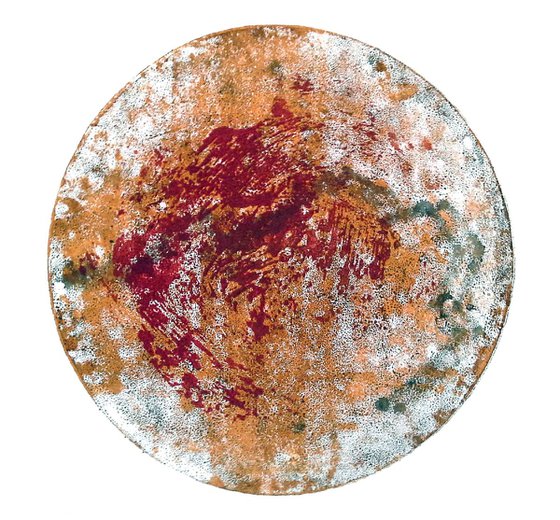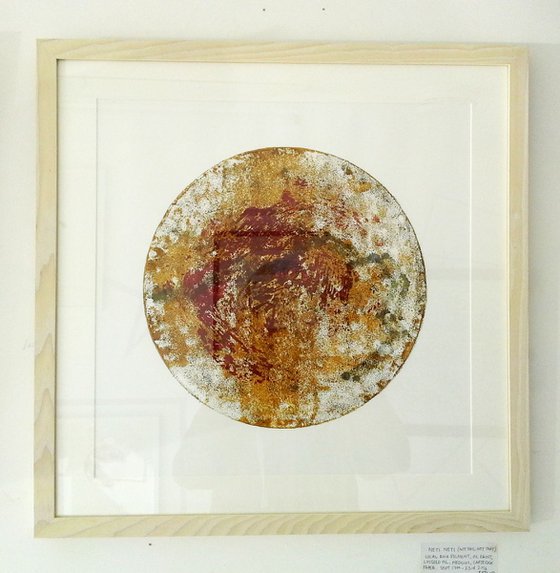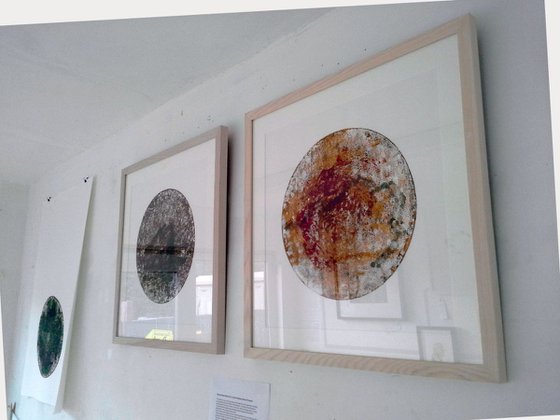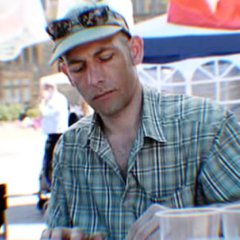- By medium
- By subject
- By budget
- Sales
- Gift cards
- Discover all art
- Artists
- Editors’ picks
- Ideas
Original artwork description:
This print is part of a series of prints entitled 'Sea of Rock' (Caspar Friedrich 'Sea of Ice'). These monotype prints explore the ideals of Romanticism laid out by Samuel Coleridge's philosophy. These explore the idea that for a work of art to be considered part of Romanticism, it had to flow from the feelings of the artist, with no boundaries and no preconceived concept, produced without a set idea in mind before its making, The work of art, whether visual or written (novel, poetry), had to follow 'creativity from nothingness' (Wordsworth) and that an artist worked with the material collaboratively, allowing process of material to begin forming into what it wished to become. Coleridge, Turner, Wordsworth and Friedrich followed these ideas, forming work through the gradual process of evolving the image and its style. This corresponds to Zen philosophical ideas concerning the nature of ideas, Taoism and beauty in art. (Aesthetics)
These series of prints were created at Contains Art in Watchet, Somerset during a residency as part of the Somerset Open Studios Pathway Bursary Award. Watchet is a place steeped in history and linked to Samuel Coleridge, Father of Romanticism. Over a period of two years he wrote the famous poems Kubla Khan and Rime of the Ancient Mariner, visiting Watchet (staying at the Bell Inn with Wordsworth and his Sister) during long walks to Porlock from Nether Stowey.
These prints use the local rock that I handmade into printing ink. I explore the monotype printing method, working with the rock pigments, collaboratively producing the subsequent print-paintings. There is a beauty revealed through the medium, glistening and creating an illusion of space and depth without the tropes of false perspectival shifts, resonating with Japanese printmaking and their lack of fixed points of perspective, before being influenced from the Dutch.
The material goes where it wants to go, whilst a little coaxing of the material, through the artist's intervention, fixes in place where it is felt instinctively to go. These print-paintings form abstractions, playing with ideas on the transference of thought-energy, and evidenced in the subsequent marks. In many they correspond to thoughts from memory, following the footsteps of the Romanticist ideal, resonating with the history of the area walked upon and the use of Jurassic and Triassic rocks as pigment, releasing their compressed energy and transformed into new layers of form. The pigments also contain ammonite fossils found within the fossil rocks on Fossil Beach.
This particular print explores mixing local natural pigments and human made pigments - symbolic of the layering of human's effect upon the landscape and the Anthropocene Age.
I have named the colours: Coleridge Red, Mariner Grey, Fossil Black, Fossil Grey, Sea Breeze, Watchet White mixed with Indian Yellow Pigment and Cadmium Red.
Professionally framed in Ashed Lime by Courtyard Framing in Minehead, West Somerset.
Materials used:
Rock Pigment, Medium, Linseed Oil, Turps, Sea water from a hole left by a fossil hunter
Tags:
#adam grose #hidden landscape #epigenetics #rock pigments #netineti #hidden memory #printpainting #alternative landscape #abstract expressionism #fine art #colourfull #print #printmaking #emotive #monotype #memories #enso #environmental #printing #abstract expresionism #post nuclear landscapeNETI NETI (Not This, Not That) (2016) Monoprint
by Adam Grose MA PGCE
19 Artist Reviews
£850 Sold
- Monoprint on Paper
- One of a kind artwork
- Size: 55 x 55 x 2cm (framed) / 30 x 30cm (actual image size)
- Framed and ready to hang
- Signed on the back
- Style: Expressive and gestural
- Subject: Abstract and non-figurative
Do you like this artwork?
This artwork has sold, but the artist is accepting commission requests. Commissioning an artwork is easy and you get a perfectly personalised piece.
Loading
Original artwork description
This print is part of a series of prints entitled 'Sea of Rock' (Caspar Friedrich 'Sea of Ice'). These monotype prints explore the ideals of Romanticism laid out by Samuel Coleridge's philosophy. These explore the idea that for a work of art to be considered part of Romanticism, it had to flow from the feelings of the artist, with no boundaries and no preconceived concept, produced without a set idea in mind before its making, The work of art, whether visual or written (novel, poetry), had to follow 'creativity from nothingness' (Wordsworth) and that an artist worked with the material collaboratively, allowing process of material to begin forming into what it wished to become. Coleridge, Turner, Wordsworth and Friedrich followed these ideas, forming work through the gradual process of evolving the image and its style. This corresponds to Zen philosophical ideas concerning the nature of ideas, Taoism and beauty in art. (Aesthetics)
These series of prints were created at Contains Art in Watchet, Somerset during a residency as part of the Somerset Open Studios Pathway Bursary Award. Watchet is a place steeped in history and linked to Samuel Coleridge, Father of Romanticism. Over a period of two years he wrote the famous poems Kubla Khan and Rime of the Ancient Mariner, visiting Watchet (staying at the Bell Inn with Wordsworth and his Sister) during long walks to Porlock from Nether Stowey.
These prints use the local rock that I handmade into printing ink. I explore the monotype printing method, working with the rock pigments, collaboratively producing the subsequent print-paintings. There is a beauty revealed through the medium, glistening and creating an illusion of space and depth without the tropes of false perspectival shifts, resonating with Japanese printmaking and their lack of fixed points of perspective, before being influenced from the Dutch.
The material goes where it wants to go, whilst a little coaxing of the material, through the artist's intervention, fixes in place where it is felt instinctively to go. These print-paintings form abstractions, playing with ideas on the transference of thought-energy, and evidenced in the subsequent marks. In many they correspond to thoughts from memory, following the footsteps of the Romanticist ideal, resonating with the history of the area walked upon and the use of Jurassic and Triassic rocks as pigment, releasing their compressed energy and transformed into new layers of form. The pigments also contain ammonite fossils found within the fossil rocks on Fossil Beach.
This particular print explores mixing local natural pigments and human made pigments - symbolic of the layering of human's effect upon the landscape and the Anthropocene Age.
I have named the colours: Coleridge Red, Mariner Grey, Fossil Black, Fossil Grey, Sea Breeze, Watchet White mixed with Indian Yellow Pigment and Cadmium Red.
Professionally framed in Ashed Lime by Courtyard Framing in Minehead, West Somerset.
Materials used:
Rock Pigment, Medium, Linseed Oil, Turps, Sea water from a hole left by a fossil hunter
Tags:
#adam grose #hidden landscape #epigenetics #rock pigments #netineti #hidden memory #printpainting #alternative landscape #abstract expressionism #fine art #colourfull #print #printmaking #emotive #monotype #memories #enso #environmental #printing #abstract expresionism #post nuclear landscape14 day money back guaranteeLearn more





